Grain Production Space Reconstruction and Its Influencing Factors in the Loess Plateau
Abstract
:1. Introduction
2. Material and Methods
2.1. Analysis Framework
2.2. Study Area
2.3. Data Sources
2.4. GAEZ Model
2.5. Landscape Pattern Index
2.6. Gravity Center Model
2.7. Spatial Econometric Regression Model
3. Results
3.1. Quantity Reconstruction of Grain Production Space
3.2. Quality Reconstruction of Grain Production Space
3.3. Pattern Reconstruction of Grain Production Space
3.4. Driving Factors for Grain Production Space Reconstruction
4. Discussion
5. Conclusions
Author Contributions
Funding
Institutional Review Board Statement
Informed Consent Statement
Data Availability Statement
Conflicts of Interest
References
- Verburg, P.H.; Crossman, N.; Ellis, E.C.; Heinimann, A.; Hostert, P.; Mertz, O.; Nagendra, H.; Sikor, T.; Erb, K.-H.; Golubiewski, N.; et al. Land system science and sustainable development of the earth system: A global land project perspective. Anthropocene 2015, 12, 29–41. [Google Scholar] [CrossRef] [Green Version]
- Li, F.; Zhou, M.; Qin, Z. Generated land systems: Recognition and prospects of land system science. Environ. Rev. 2020, 28, 199–207. [Google Scholar] [CrossRef]
- Leyk, S.; Uhl, J.H.; Connor, D.S.; Braswell, A.E.; Mietkiewicz, N.; Balch, J.K.; Gutmann, M. Two centuries of settlement and urban development in the United States. Sci. Adv. 2020, 6, eaba2937. [Google Scholar] [CrossRef] [PubMed]
- Obersteiner, M.; Walsh, B.; Frank, S.; Havlík, P.; Cantele, M.; Liu, J.; Palazzo, A.; Herrero, M.; Lu, Y.; Mosnier, A.; et al. Assessing the land resource–food price nexus of the Sustainable Development Goals. Sci. Adv. 2016, 2, e1501499. [Google Scholar] [CrossRef] [Green Version]
- Meyfroidt, P.; Chowdhury, R.R.; de Bremond, A.; Ellis, E.C.; Erb, K.-H.; Filatova, T.; Garrett, R.D.; Grove, J.M.; Heinimann, A.; Kuemmerle, T.; et al. Middle-range theories of land system change. Glob. Environ. Chang. 2018, 53, 52–67. [Google Scholar] [CrossRef]
- Zhang, Q.-M.; Yang, F.-S.; Li, F. The grain production space reconstruction in China since the reform and opening up. J. Nat. Resour. 2021, 36, 1426–1438. [Google Scholar] [CrossRef]
- Li, F.; Qin, Z.; Liu, X.; Chen, Z.; Wei, X.; Zhang, Q.; Lei, M. Grain production space reconstruction and land system function tradeoffs in China. Geogr. Sustain. 2021, 2, 22–30. [Google Scholar] [CrossRef]
- Gao, L.; Bryan, B.A. Finding pathways to national-scale land-sector sustainability. Nature 2017, 544, 217–222. [Google Scholar] [CrossRef]
- Hasegawa, T.; Havlik, P.; Frank, S.; Palazzo, A.; Valin, H. Tackling food consumption inequality to fight hunger without pressuring the environment. Nat. Sustain. 2019, 2, 826–833. [Google Scholar] [CrossRef]
- Kang, Q.; Guo, Q.-X.; Ding, Y.; Zhang, Y. Tradeoffs/synergies analysis of “Production-Living-Ecological” functions in Shanxi province. J. Nat. Resour. 2021, 36, 1195–1207. [Google Scholar] [CrossRef]
- Foley, J.A.; DeFries, R.; Asner, G.P.; Barford, C.; Bonan, G.; Carpenter, S.R.; Chapin, F.S.; Coe, M.T.; Daily, G.C.; Gibbs, H.K.; et al. Global consequences of land use. Science 2005, 309, 570–574. [Google Scholar] [CrossRef] [PubMed] [Green Version]
- Liu, J.; Kuang, W.; Zhang, Z.; Xu, X.; Qin, Y.; Ning, J.; Zhou, W.; Zhang, S.; Li, R.; Yan, C.; et al. Spatiotemporal characteristics, patterns, and causes of land-use changes in China since the late 1980s. J. Geogr. Sci. 2014, 24, 195–210. [Google Scholar] [CrossRef]
- Liu, J.Y.; Ning, J.; Kuang, W.H.; Xu, X.L.; Zhang, S.W.; Yan, C.Z.; Li, R.D.; Wu, S.X.; Hu, Y.F.; Du, G.M.; et al. Spatio-temporal patterns and characteristics of land-use change in China during 2010–2015. Acta Geogr. Sin. 2018, 73, 789–802. [Google Scholar]
- Zhang, L.J.; Yao, Z.Y.; Tang, S.H.; Li, X.Y.; Hao, T.T. Spatiotemporal characteristics and patterns of the global cultivated land since the 1980s. Acta Geogr. Sin. 2017, 72, 1235–1247. [Google Scholar]
- Homer, C.; Dewitz, J.; Jin, S.; Xian, G.; Costello, C.; Danielson, P.; Gass, L.; Funk, M.; Wickham, J.; Stehman, S.; et al. Conterminous United States land cover change patterns 2001–2016 from the 2016 National Land Cover Database. ISPRS J. Photogramm. Remote Sens. 2020, 162, 184–199. [Google Scholar] [CrossRef]
- Winkler, K.; Fuchs, R.; Rounsevell, M.; Herold, M. Global land use changes are four times greater than previously estimated. Nat. Commun. 2021, 12, 2501. [Google Scholar] [CrossRef]
- Canaz, S.; Aliefendioğlu, Y.; Tanrıvermiş, H. Change detection using Landsat images and an analysis of the linkages between the change and property tax values in the Istanbul Province of Turkey. J. Environ. Manag. 2017, 200, 446–455. [Google Scholar] [CrossRef]
- Bren D’Amour, C.; Reitsma, F.; Baiocchi, G.; Barthel, S.; Güneralp, B.; Erb, K.-H.; Haberl, H.; Creutzig, F.; Seto, K.C. Future urban land expansion and implications for global croplands. Proc. Natl. Acad. Sci. USA 2017, 114, 8939–8944. [Google Scholar] [CrossRef] [Green Version]
- Huang, D.; Zhu, S.; Liu, T. Are there differences in the forces driving the conversion of different non-urban lands into urban use? A case study of Beijing. Environ. Sci. Pollut. Res. 2022, 29, 6414–6432. [Google Scholar] [CrossRef]
- Liu, X.; Zhao, C.; Song, W. Review of the evolution of cultivated land protection policies in the period following China’s reform and liberalization. Land Use Policy 2017, 67, 660–669. [Google Scholar] [CrossRef]
- Raghavan, R.; Shrimali, G. Forest cover increase in India: The role of policy and markets. For. Policy Econ. 2015, 61, 70–76. [Google Scholar] [CrossRef]
- Hailu, A.; Mammo, S.; Kidane, M. Dynamics of land use, land cover change trend and its drivers in Jimma Geneti District, Western Ethiopia. Land Use Policy 2020, 99, 105011. [Google Scholar] [CrossRef]
- Arowolo, A.O.; Deng, X. Land use/land cover change and statistical modelling of cultivated land change drivers in Nigeria. Reg. Environ. Chang. 2018, 18, 247–259. [Google Scholar] [CrossRef]
- Rossiter, D.G. A theoretical framework for land evaluation. Geoderma 1996, 72, 165–190. [Google Scholar] [CrossRef]
- Leonard, B.; Parker, D.P.; Anderson, T.L. Land quality, land rights, and indigenous poverty. J. Dev. Econ. 2020, 143, 102435. [Google Scholar] [CrossRef]
- Kurmangozhinov, A.; Xue, W.; Li, X.; Zeng, F.; Sabit, R.; Tusun, T. High biomass production with abundant leaf litterfall is critical to ameliorating soil quality and productivity in reclaimed sandy desertification land. J. Environ. Manag. 2020, 263, 110373. [Google Scholar] [CrossRef] [PubMed]
- Jin, H.; Zhong, Y.; Shi, D.; Li, J.; Lou, Y.; Li, Y.; Li, J. Quantifying the impact of tillage measures on the cultivated-layer soil quality in the red soil hilly region: Establishing the thresholds of the minimum data set. Ecol. Indic. 2021, 130, 108013. [Google Scholar] [CrossRef]
- Fu, G.Z.; Bai, W.Q. Advances and prospects of evaluating cultivated land quality. Resour. Sci. 2015, 37, 226–236. [Google Scholar]
- Al-Kayssi, A.; Mustafa, S. Impact of elevated carbon dioxide on soil heat storage and heat flux under unheated low-tunnels conditions. J. Environ. Manag. 2016, 182, 176–186. [Google Scholar] [CrossRef]
- Veljanoska, S. Can Land Fragmentation Reduce the Exposure of Rural Households to Weather Variability? Ecol. Econ. 2018, 154, 42–51. [Google Scholar] [CrossRef] [Green Version]
- Fuentes-Guevara, M.D.; Armindo, R.A.; Timm, L.C.; Faria, L.C. Examining the land leveling impacts on the physical quality of lowland soils in Southern Brazil. Soil Tillage Res. 2022, 215, 105217. [Google Scholar] [CrossRef]
- Van Vliet, J.; de Groot, H.L.F.; Rietveld, P.; Verburg, P.H. Manifestations and underlying drivers of agricultural land use change in Europe. Landsc. Urban Plan. 2015, 133, 24–36. [Google Scholar] [CrossRef] [Green Version]
- Johnson, J.A.; Runge, C.F.; Senauer, B.; Foley, J.; Polasky, S. Global agriculture and carbon trade-offs. Proc. Natl. Acad. Sci. USA 2014, 111, 12342–12347. [Google Scholar] [CrossRef] [PubMed] [Green Version]
- Irwin, E.G.; Bockstael, N.E. The evolution of urban sprawl: Evidence of spatial heterogeneity and increasing land fragmentation. Proc. Natl. Acad. Sci. USA 2007, 104, 20672–20677. [Google Scholar] [CrossRef] [Green Version]
- Jiang, P.; Li, M.; Lv, J. The causes of farmland landscape structural changes in different geographical environments. Sci. Total Environ. 2019, 685, 667–680. [Google Scholar] [CrossRef]
- Liang, J.; Pan, S.; Chen, W.; Li, J.; Zhou, T. Cultivated Land Fragmentation and Its Influencing Factors Detection: A Case Study in Huaihe River Basin, China. Int. J. Environ. Res. Public Health 2022, 19, 138. [Google Scholar] [CrossRef]
- Cheng, W.M.; Gao, X.Y.; Ma, T.; Xu, X.L.; Chen, Y.J.; Zhou, C.H. Spatial-temporal distribution of cropland in China based on geomorphologic regionalization during 1990–2015. Acta Geogr. Sin. 2018, 73, 1613–1629. [Google Scholar]
- Zhang, Y.N.; Long, H.L.; Ge, D.Z.; Tu, S.S.; Qu, Y. Spatio-temporal characteristics and dynamic mechanism of farmland functions evolution in the Huang-Huai-Hai Plain. Acta Geogr. Sin. 2018, 73, 518–534. [Google Scholar]
- Bateman, I.; Agarwala, M.; Binner, A.; Coombes, E.; Day, B.; Ferrini, S.; Fezzi, C.; Hutchins, M.; Lovett, A.; Posen, P. Spatially explicit integrated modeling and economic valuation of climate driven land use change and its indirect effects. J. Environ. Manag. 2016, 181, 172–184. [Google Scholar] [CrossRef]
- Uisso, A.M.; Tanrıvermiş, H. Driving factors and assessment of changes in the use of arable land in Tanzania. Land Use Policy 2021, 104, 105359. [Google Scholar] [CrossRef]
- Song, X.-P.; Hansen, M.C.; Stehman, S.V.; Potapov, P.V.; Tyukavina, A.; Vermote, E.F.; Townshend, J.R. Global land change from 1982 to 2016. Nature 2018, 560, 639–643. [Google Scholar] [CrossRef] [PubMed]
- Shi, G.; Ye, P.; Ding, L.; Quinones, A.; Li, Y.; Jiang, N. Spatio-Temporal Patterns of Land Use and Cover Change from 1990 to 2010: A Case Study of Jiangsu Province, China. Int. J. Environ. Res. Public Health 2019, 16, 907. [Google Scholar] [CrossRef] [PubMed] [Green Version]
- Tubiello, F.N.; Fischer, G. Reducing climate change impacts on agriculture: Global and regional effects of mitigation, 2000–2080. Technol. Forecast. Soc. Chang. 2007, 74, 1030–1056. [Google Scholar] [CrossRef]
- Ge, D.; Long, H.; Zhang, Y.; Ma, L.; Li, T. Farmland transition and its influences on grain production in China. Land Use Policy 2018, 70, 94–105. [Google Scholar] [CrossRef]
- Fischer, G.; Sun, L. Model based analysis of future land-use development in China. Agric. Ecosyst. Environ. 2001, 85, 163–176. [Google Scholar] [CrossRef]
- Xu, X.; Wang, L.; Cai, H.; Wang, L.; Liu, L.; Wang, H. The influences of spatiotemporal change of cultivated land on food crop production potential in China. Food Secur. 2017, 9, 485–495. [Google Scholar] [CrossRef]
- Liao, M.-T.; Wei, F. Analysis of grain production and development potentiality in Central Asia based on GAEZ method. J. Nat. Resour. 2021, 36, 582–593. [Google Scholar] [CrossRef]
- Klein, L.R. Measurement of a shift in the world’s center of economic gravity. J. Policy Model. 2009, 31, 489–492. [Google Scholar] [CrossRef]
- Liu, Y.S.; Wang, J.Y.; Guo, L.Y. The Spatial-Tempsoral Changes of Grain Production and Arable Land in China. Sci. Agric. Sin. 2009, 42, 4269–4274. [Google Scholar]
- Grether, J.M.; Mathys, N.A. Is the world’s economic center of gravity already in Asia. AREA 2010, 42, 47–50. [Google Scholar] [CrossRef]
- Liang, L.; Chen, M.; Luo, X.; Xian, Y. Changes pattern in the population and economic gravity centers since the Reform and Opening up in China: The widening gaps between the South and North. J. Clean. Prod. 2021, 310, 127379. [Google Scholar] [CrossRef]
- Anselin, L. Spatial Econometrics: Methods and Models; Springer: Dordrecht, The Netherlands, 1988; pp. 16–21. [Google Scholar] [CrossRef] [Green Version]
- Anselin, L. Under the hood Issues in the specification and interpretation of spatial regression models. Agric. Econ. 2002, 27, 247–267. [Google Scholar] [CrossRef]
- Liu, Y.; Long, H. Land use transitions and their dynamic mechanism: The case of the Huang-Huai-Hai Plain. J. Geogr. Sci. 2016, 26, 515–530. [Google Scholar] [CrossRef] [Green Version]
- Tian, J.; Wang, B.; Zhang, C.; Li, W.; Wang, S. Mechanism of regional land use transition in underdeveloped areas of China: A case study of northeast China. Land Use Policy 2020, 94, 104538. [Google Scholar] [CrossRef]
- Hao, Y.; Liu, Y.-M. The influential factors of urban PM2.5 concentrations in China: A spatial econometric analysis. J. Clean. Prod. 2016, 112, 1443–1453. [Google Scholar] [CrossRef]
- Chazdon, R.L. Beyond Deforestation: Restoring Forests and Ecosystem Services on Degraded Lands. Science 2008, 320, 1458–1460. [Google Scholar] [CrossRef] [Green Version]
- Meyfroidt, P.; Lambin, E.F.; Erb, K.-H.; Hertel, T.W. Globalization of land use: Distant drivers of land change and geographic displacement of land use. Curr. Opin. Environ. Sustain. 2013, 5, 438–444. [Google Scholar] [CrossRef]
- Newman, M.E.; McLaren, K.P.; Wilson, B.S. Long-term socio-economic and spatial pattern drivers of land cover change in a Caribbean tropical moist forest, the Cockpit Country, Jamaica. Agric. Ecosyst. Environ. 2014, 186, 185–200. [Google Scholar] [CrossRef]
- Karimi, A.; Hockings, M. A social-ecological approach to land-use conflict to inform regional and conservation planning and management. Landsc. Ecol. 2018, 33, 691–710. [Google Scholar] [CrossRef]
- Qu, Y.; Zong, H.; Su, D.; Ping, Z.; Guan, M. Land Use Change and Its Impact on Landscape Ecological Risk in Typical Areas of the Yellow River Basin in China. Int. J. Environ. Res. Public Health 2021, 18, 11301. [Google Scholar] [CrossRef]
- Da Silva, R.F.B.; Batistella, M.; Moran, E.F. Socioeconomic changes and environmental policies as dimensions of regional land transitions in the Atlantic Forest, Brazil. Environ. Sci. Policy 2017, 74, 14–22. [Google Scholar] [CrossRef]
- Gong, B.; Liu, Z. Assessing impacts of land use policies on environmental sustainability of oasis landscapes with scenario analysis: The case of northern China. Landsc. Ecol. 2021, 36, 1913–1932. [Google Scholar] [CrossRef]
- Zewdie, M.; Worku, H.; Bantider, A. Temporal Dynamics of the Driving Factors of Urban Landscape Change of Addis Ababa During the Past Three Decades. Environ. Manag. 2018, 61, 132–146. [Google Scholar] [CrossRef] [PubMed]
- Ma, E.P.; Cai, J.M.; Lin, J.; Han, Y.; Liao, L.W.; Han, W. Explanation of land use/cover change from the perspective of tele-coupling. Acta Geogr. Sin. 2019, 74, 421–431. [Google Scholar]
- Ducey, M.J.; Johnson, K.M.; Belair, E.P.; Cook, B.D. The Influence of Human Demography on Land Cover Change in the Great Lakes States, USA. Environ. Manag. 2018, 62, 1089–1107. [Google Scholar] [CrossRef]
- Zhang, B.L.; Gao, J.B.; Gao, Y.; Cai, W.M.; Zhang, F.R. Land use transition of mountainous rural areas in China. Acta Geogr. Sin. 2018, 73, 503–517. [Google Scholar]
- Ariti, A.T.; van Vliet, J.; Verburg, P.H. The role of institutional actors and their interactions in the land use policy making process in Ethiopia. J. Environ. Manag. 2019, 237, 235–246. [Google Scholar] [CrossRef]
- Nguyen, T.H.T.; Tran, V.T.; Bui, Q.T.; Man, Q.H.; Walter, T.D.V. Socio-economic effects of agricultural land conversion for urban development: Case study of Hanoi, Vietnam. Land Use Policy 2016, 54, 583–592. [Google Scholar] [CrossRef]
- Subedi, Y.R.; Kristiansen, P.; Cacho, O.; Ojha, R.B. Agricultural Land Abandonment in the Hill Agro-ecological Region of Nepal: Analysis of Extent, Drivers and Impact of Change. Environ. Manag. 2021, 67, 1100–1118. [Google Scholar] [CrossRef]
- Heider, K.; Lopez, J.M.R.; Balbo, A.L.; Scheffran, J. The state of agricultural landscapes in the Mediterranean: Smallholder agriculture and land abandonment in terraced landscapes of the Ricote Valley, southeast Spain. Reg. Environ. Chang. 2021, 21, 23. [Google Scholar] [CrossRef]

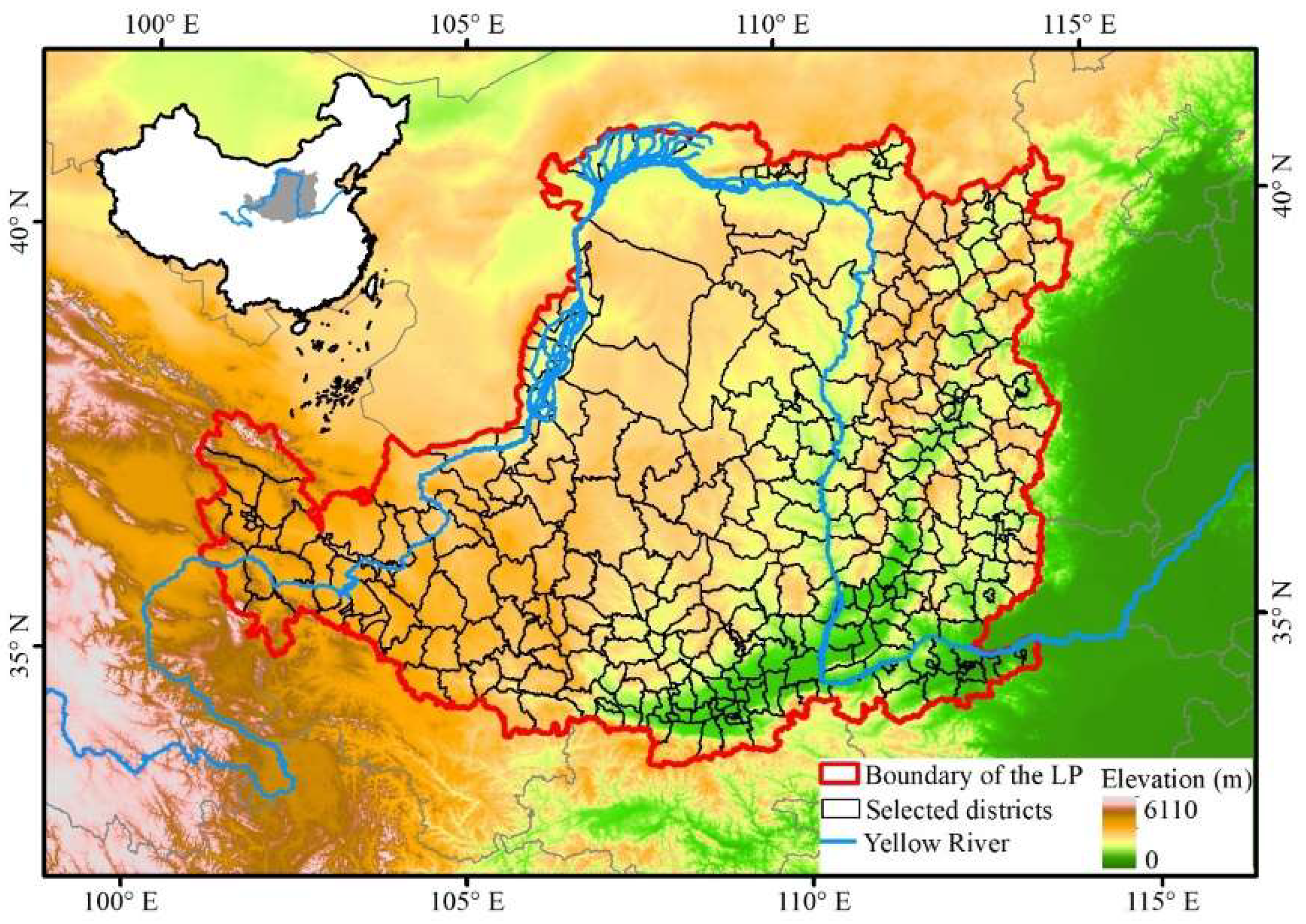
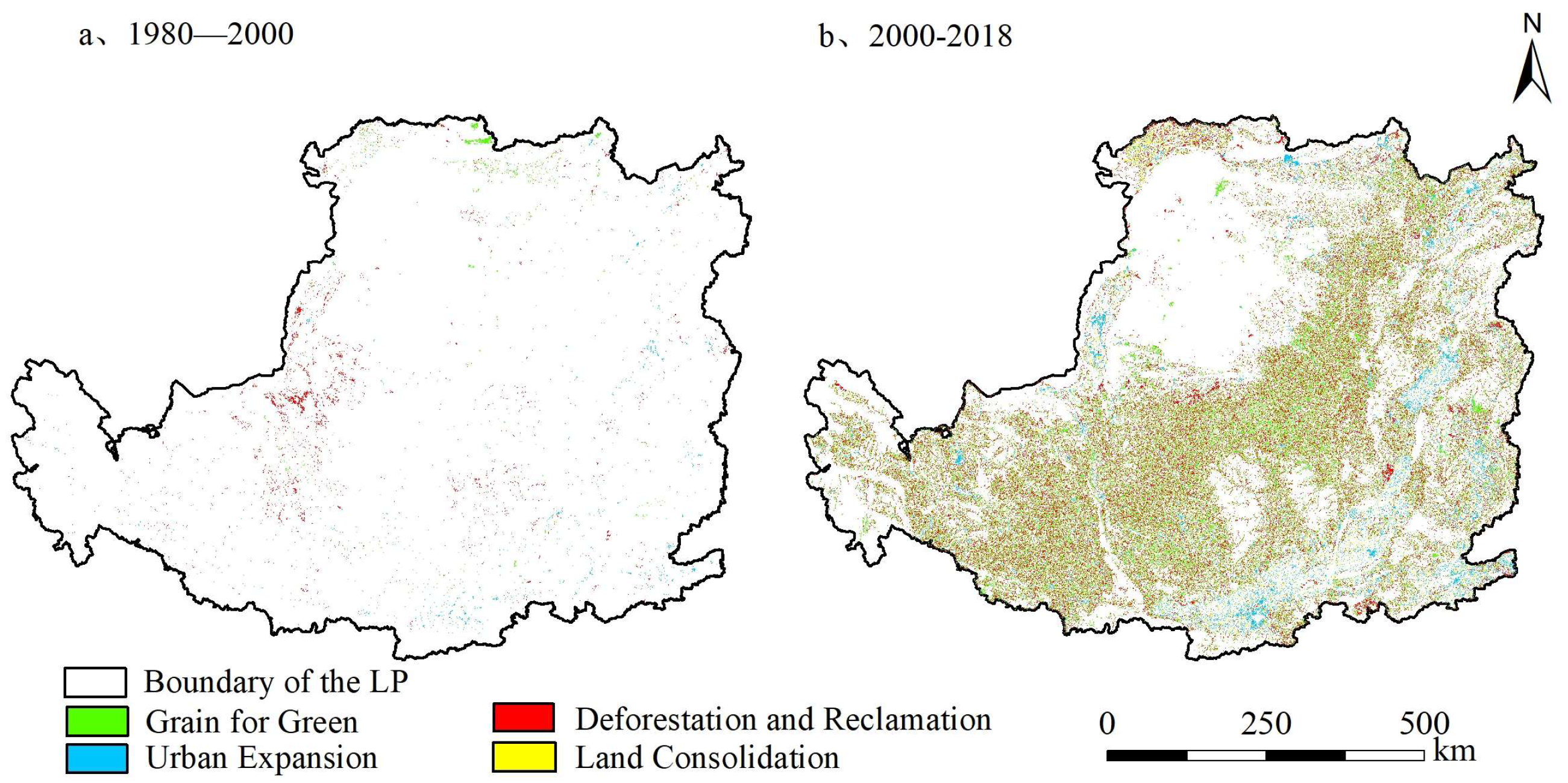

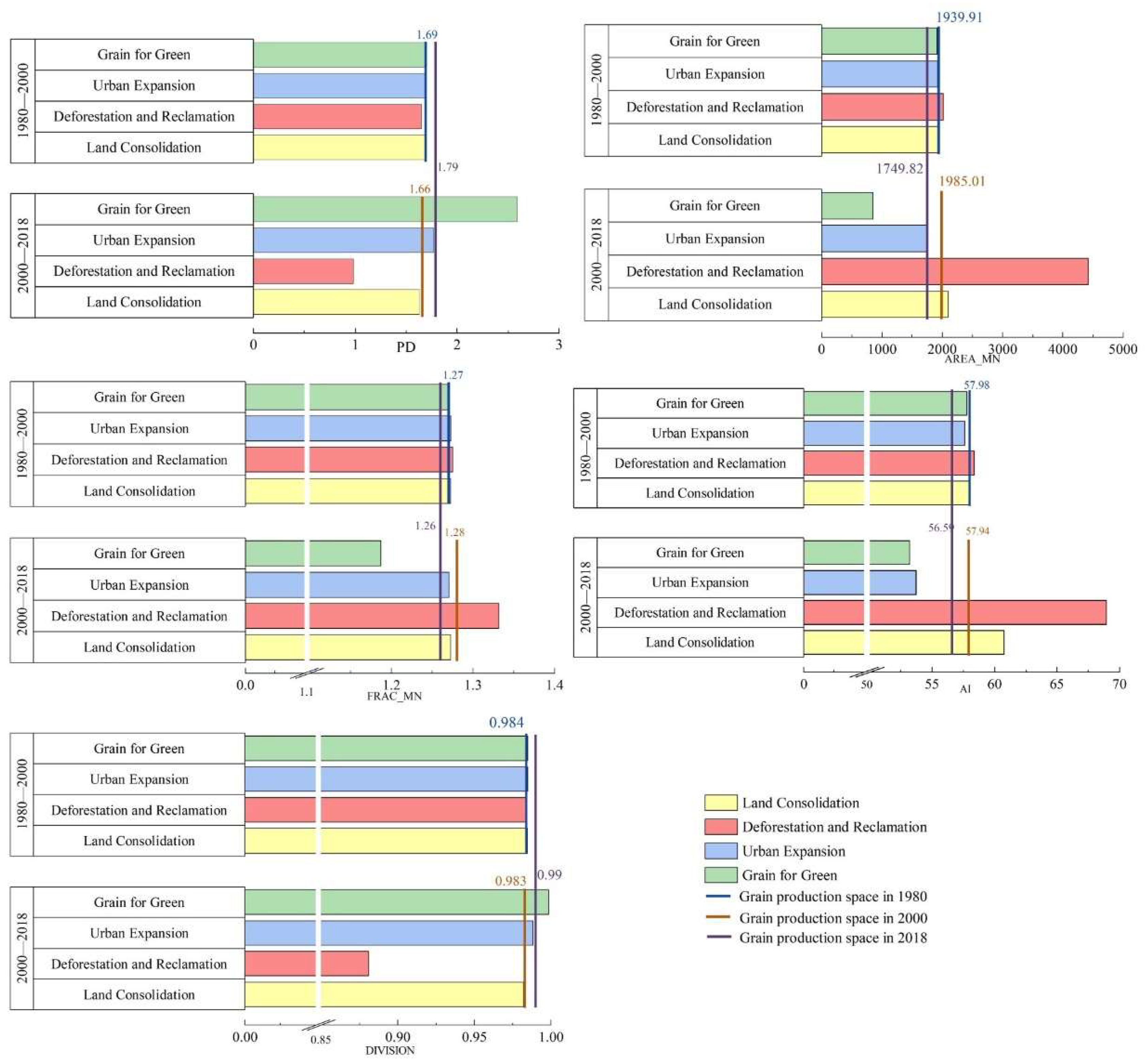
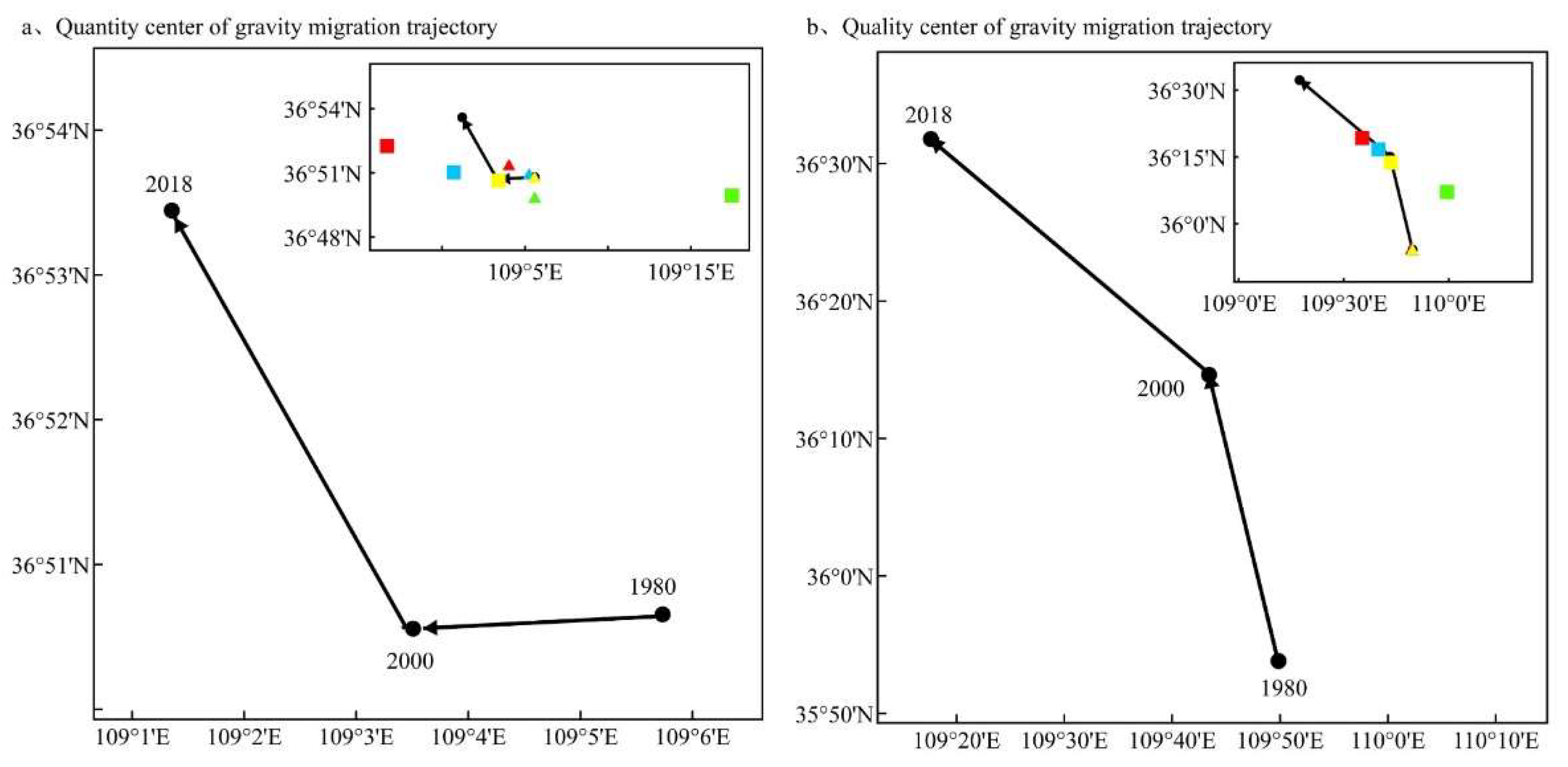
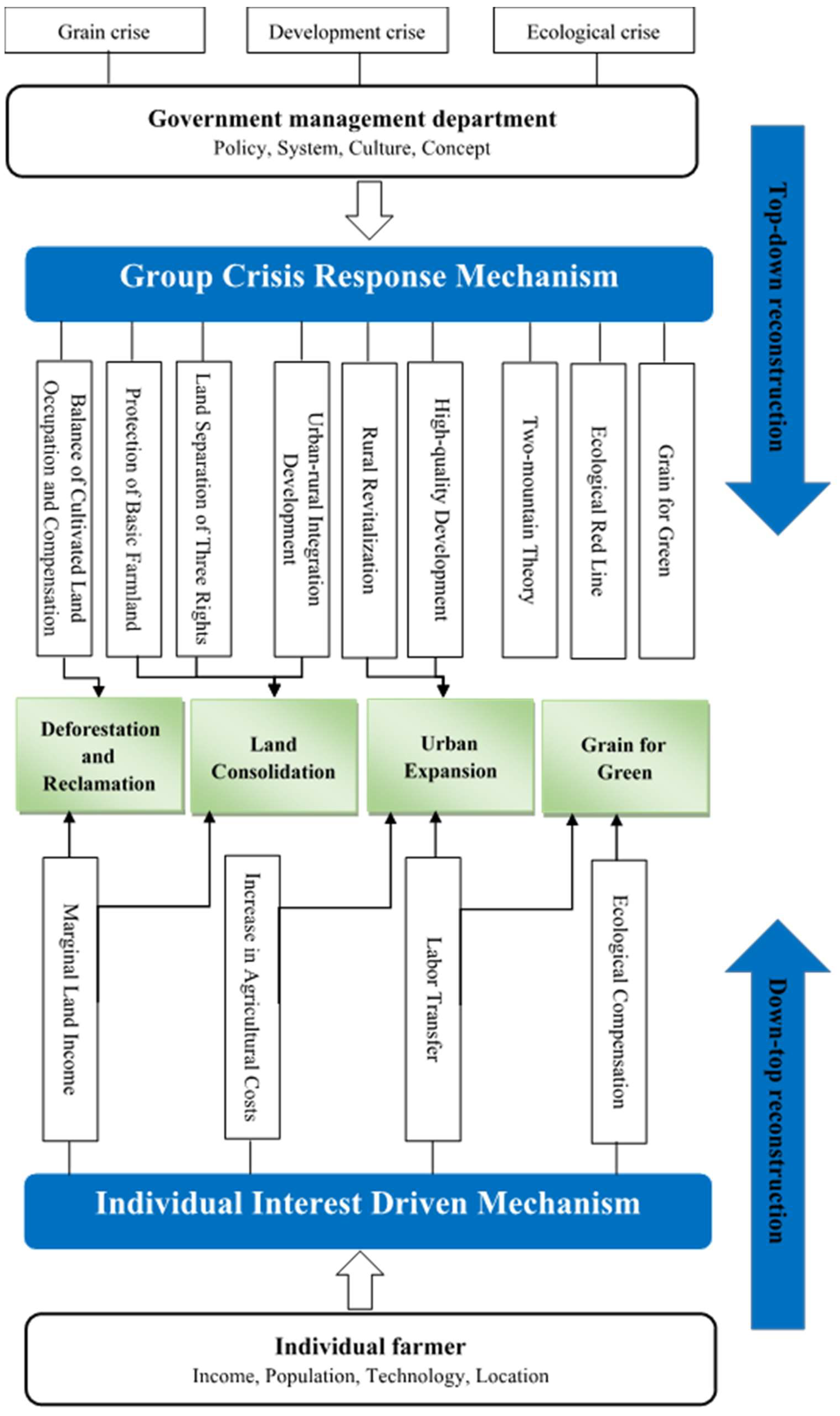
| Data Type | Key Indicators | Data Source | Temporal Attribute |
|---|---|---|---|
| Land use data | Grain production space Urban-rural development space Ecological service space | Chinese Academy of Sciences Resource and Environmental Science Data Center | 1980; 2000; 2018 |
| Meteorological data | Precipitation Mean maximum temperature Mean minimum temperature Wind speed Relative humidity Rainfall day Solar radiation | China Meteorological Administration | Monthly; 1980–2018 |
| Topographic data | DEM | U.S. Space Shuttle Radar Topography Mission | 2008 |
| River data | River density | National Basic Geographic Information System | 2017 |
| Transportation network | Highway mileage Railway mileage | Atlas of China and Atlas of China Transportation published by Sinomap press | 1981; 2019 |
| Socioeconomic data | Total population Gross domestic product | China Statistical Yearbook (The missing statistics were inferred from the GM (1,1) model) | 1980; 2018 |
| Time | Quantity/km2 | Proportion of Land System |
|---|---|---|
| 1980 | 204,331 | 32.70% |
| 2000 | 206,262 | 33.01% |
| 2018 | 195,175 | 31.24% |
| Stage | Reconstruction Pathway | Difference from the Average Quality in Initial Year (kg/hm2) |
|---|---|---|
| 1980–2000 | Grain for Green | 16.61 |
| Urban Expansion | −14.16 | |
| Deforestation and Reclamation | −39.59 | |
| Land Consolidation | 0.03 | |
| 2000–2018 | Grain for Green | 298.61 |
| Urban Expansion | −62.30 | |
| Deforestation and Reclamation | −155.07 | |
| Land Consolidation | 21.59 |
| Statistical Tests | Grain for Green | Urban Expansion | Deforestation and Reclamation | Land Consolidation |
|---|---|---|---|---|
| Moran’s I | 0.6241 *** | 0.3051 *** | 0.6062 *** | 0.4542 *** |
| White test | 0.091 * | 0.000 *** | 0.223 | 0.008 *** |
| Lagrange Multiplier (lag) | 182.375 *** | 30.23 *** | 175.957 *** | 129.322 *** |
| Robust LM (lag) | 16.462 *** | 1.434 | 22.989 *** | 27.328 *** |
| Lagrange Multiplier (error) | 168.935 *** | 43.76 *** | 153.276 *** | 105.439 *** |
| Robust LM (error) | 3.022 * | 14.963 *** | 0.308 | 3.444 * |
| Driving Factors | Grain for Green | Urban Expansion | Deforestation and Reclamation | Land Consolidation |
|---|---|---|---|---|
| Average altitude | −0.039 | 0.001 | −0.020 | 0.002 |
| Average slope | 9.649 *** | −1.633 *** | 6.742 *** | −0.868 *** |
| River density | 6.684 | −8.526 | −91.759 | 0.629 |
| Average temperature change | −12.481 | 1.766 | −7.083 | −2.901 |
| Average precipitation change | 0.262 ** | −0.063 ** | 0.157 | −0.013 |
| Total population change | −0.232 | 0.055 | 0.285 | 0.016 |
| GDP change | 0.008 | 0.034 *** | −0.016 | −0.009 |
| Highway mileage change | 0.486 *** | 0.067 *** | 0.445 *** | 0.024 ** |
| Railway mileage change | 0.358 | 0.188 *** | 0.302 | 0.060 ** |
| W-Y | 0.686 *** | 0.701 *** | 0.727 *** | |
| Lambda | 0.439 *** | |||
| R2 | 0.650 | 0.395 | 0.628 | 0.496 |
| LogL | −2131.41 | −1550.65 | −2110.84 | −1424.08 |
| AIC | 4284.82 | 3121.32 | 4243.69 | 2870.16 |
| SC | 4326.68 | 3159.37 | 4285.54 | 2912.02 |
Publisher’s Note: MDPI stays neutral with regard to jurisdictional claims in published maps and institutional affiliations. |
© 2022 by the authors. Licensee MDPI, Basel, Switzerland. This article is an open access article distributed under the terms and conditions of the Creative Commons Attribution (CC BY) license (https://creativecommons.org/licenses/by/4.0/).
Share and Cite
Qin, Z.; Liu, X.; Lu, X.; Li, M.; Li, F. Grain Production Space Reconstruction and Its Influencing Factors in the Loess Plateau. Int. J. Environ. Res. Public Health 2022, 19, 5876. https://doi.org/10.3390/ijerph19105876
Qin Z, Liu X, Lu X, Li M, Li F. Grain Production Space Reconstruction and Its Influencing Factors in the Loess Plateau. International Journal of Environmental Research and Public Health. 2022; 19(10):5876. https://doi.org/10.3390/ijerph19105876
Chicago/Turabian StyleQin, Zhangxuan, Xiaolin Liu, Xiaoyan Lu, Mengfei Li, and Fei Li. 2022. "Grain Production Space Reconstruction and Its Influencing Factors in the Loess Plateau" International Journal of Environmental Research and Public Health 19, no. 10: 5876. https://doi.org/10.3390/ijerph19105876







